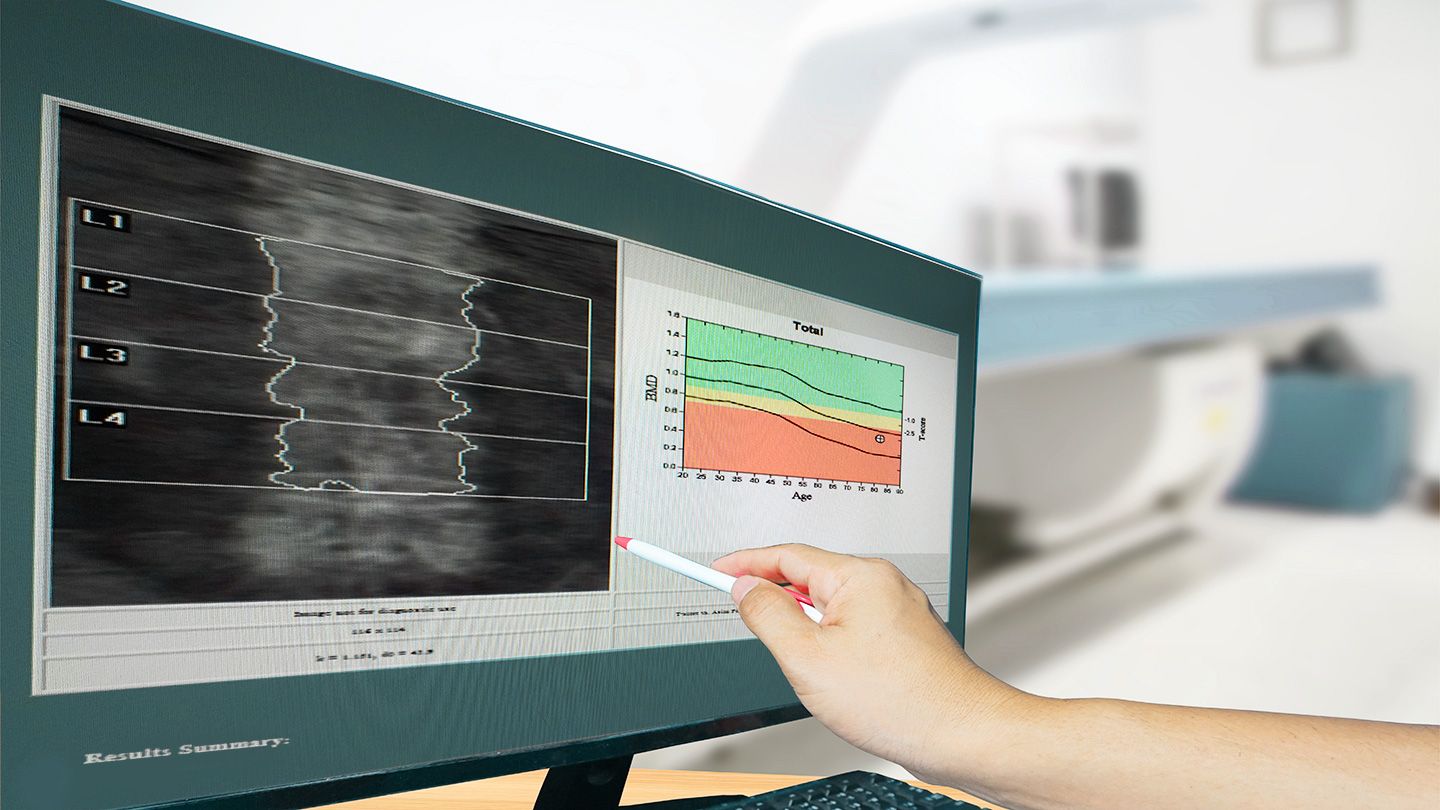Osteoporosis is a bone disease that’s common in the United States, affecting almost 20 percent of women and 5 percent of men over age 50.e60dc2a1-f33c-4a05-9b50-8e3e8e5976298265077e-fe76-4e85-bb84-2903a0c13d57 Osteoporosis occurs when bones are weakened by hormone shifts from aging, medications, or other factors. In the same way that a building relies on steel scaffolding to keep it strong, the body relies on the internal scaffolding of its bones, which are primarily built at a young age. As a person gets get older — and especially after a woman goes through menopause — bones lose strength. If the bones get weak enough, they may break. To be most effective, the diagnosis and treatment of osteoporosis should happen well before a breakage, says Ira Khanna, MD , an assistant professor of rheumatology at Mount Sinai West in New York City. The best-case scenario is to catch the disease well before discernible symptoms appear. Bone mineral density screenings are used to detect osteoporosis and its precursor, osteopenia . “Results from a bone mineral density scan provide a good indication of bone strength. It is the gold standard,” Dr. Khanna says. If a screening detects the disease or finds that your bones have lower than optimal mass, you can make lifestyle changes and take medication to keep your bones as strong as possible.
What Is a Bone Mineral Density Scan? What It Is The device most commonly used to screen for osteoporosis is a type of low-level X-ray known as dual-energy X-ray absorptiometry (DEXA). It measures the amount of calcium and other minerals in your bones.e60dc2a1-f33c-4a05-9b50-8e3e8e597629308560fd-5e55-4007-9b74-41898ed6af1a The test requires a prescription from a healthcare provider. Because of the specialized machine required, it is generally performed in a radiology center or hospital. Results from the test are read by a radiologist, who then consults your primary healthcare provider to determine the best course of treatment.
Do I Need a Bone Density Scan? Who Needs It The U.S. Preventive Services Task Force currently recommends screenings for bone health for women 65 or older. (There is not enough evidence to recommend screenings for men.)e60dc2a1-f33c-4a05-9b50-8e3e8e5976293b49e633-1b7d-42f8-ad00-079b6b38cdcc Postmenopausal women younger than 65 who have a higher risk of osteoporosis should also be screened. Factors that increase risk include:e60dc2a1-f33c-4a05-9b50-8e3e8e597629418b561d-9403-4a99-a9df-4fedee46ec9c Being menopausal Having a low body weight Having a parental history of hip fracture Smoking cigarettes Drinking alcohol in excess Using certain medications, such as corticosteroids for autoimmune disease or insulin for diabetes “Women and their clinicians should be aware of the risk factors for low bone density and the need to screen those with risk factors earlier than the recommended 65 years,” says Stephanie Faubion, MD , director of the Mayo Clinic Center for Women’s Health in Rochester, Minnesota, and medical director of the The Menopause Society . You can determine if you’re at increased risk with FRAX, an online fracture risk assessment tool , along with a doctor’s appointment. Screenings are recommended every two years after the initial visit, Khanna says. People on osteoporosis medication may need to be screened more frequently to see whether the drugs are working.
What Are the Benefits of Getting a Bone Density Scan? Benefits Research has long proven that bone mineral density scans are safe and cost effective.e60dc2a1-f33c-4a05-9b50-8e3e8e59762957820b42-570e-4c14-a36a-dba0e8472358 One cost calculator estimates that with health insurance, the fee is typically just your copay, which is generally $10 to $30. Medicare also covers the screening. People who don’t have health insurance might spend $150 to $250. Compare that to the cost of breaking a bone from osteoporosis, which one study estimates to be more than $30,000.e60dc2a1-f33c-4a05-9b50-8e3e8e5976291d01f203-10e7-445b-893a-55c6e2c0cf94
Are There Risks With a Bone Density Scan? Risks DEXA screens use an extremely low level of radiation to measure bone density, which most people shouldn’t be concerned about, according to Khanna. “It is less radiation than we get from natural background radiation walking around outside,” she notes. One exception: If you’re pregnant, be sure to tell your doctor, as you should avoid exposure to radiation during pregnancy.e60dc2a1-f33c-4a05-9b50-8e3e8e597629c5473a67-803a-4798-a081-f75cd1986e63
What Does a Bone Density Test Involve? What to Expect Bone density scans don’t require much preparation. If you take calcium supplements, your doctor may ask you to stop taking them for at least 24 hours before the scan. You can wear loose, comfortable clothing, but avoid anything with metal buckles, hooks, or zippers, which may interfere with the machine. Some healthcare practitioners may provide an exam gown to change into for the screening. Unlike an enclosed MRI, a DEXA scan is done on an open X-ray table. You’ll simply lie on your back on the table for the length of the scan, which is around 10 to 30 minutes. It’s important to stay still and avoid moving during the scan, because fidgeting can blur the images. The scan itself is painless. A large scanning arm will slowly pass over parts of your body — generally, the hip and lower spine. The arm will project a narrow beam of low-dose radiation X-rays to calculate the density of your bones.e60dc2a1-f33c-4a05-9b50-8e3e8e5976296432bd82-d70b-4518-8c90-cda1f495419b
How Are the Results Evaluated? Results A bone density scan compares the results of your scan with a scan showing the expected bone density for a young, healthy adult. The difference between the two is expressed as a standard deviation score, known as a T-score.e60dc2a1-f33c-4a05-9b50-8e3e8e5976296dcd6eb6-a670-40ee-bc21-d9ecc34920ff Results are measured as follows:
Your doctor may also discuss your Z-score. This is the number of standard deviations above or below what’s expected at your: Age Weight Ethnicity or racial background If your Z-score is significantly higher or lower than average, your doctor may recommend additional testing to get to the root of the issue.e60dc2a1-f33c-4a05-9b50-8e3e8e59762947214aea-231e-43ac-8feb-8e4fc40bb568
What Should I Do if My T-Score Indicates Osteoporosis? Next Steps People whose T-score indicates significant bone loss should treat it with medication, Khanna says. Some people worry about side effects from the medicines, including the very rare risk of jawbone damage called osteonecrosis.e60dc2a1-f33c-4a05-9b50-8e3e8e597629a98a2de5-c08e-4b93-a83f-83bcc2ded97b “But when you talk about a risk-benefit analysis, the risk of not taking medication is more likely to severely impact your life and your mortality than the extremely rare risk of osteonecrosis,” she advises. There are several medicines — bisphosphonates, hormone therapy, and more — used to treat the condition. You and your physician should discuss the options to determine which is best for you.
The Takeaway A bone mineral density screening, such as a DEXA scan, is the gold standard for detecting osteoporosis (weakening of the bones) before it leads to bone fractures. A DEXA scan is painless. It involves lying still for up to 30 minutes while an X-ray is used to measure the amount of calcium and other minerals in your bones. Results from a bone mineral density screening can be used to determine if you require treatment to strengthen your bones and protect your health.
Read the full article here
Leave a comment




